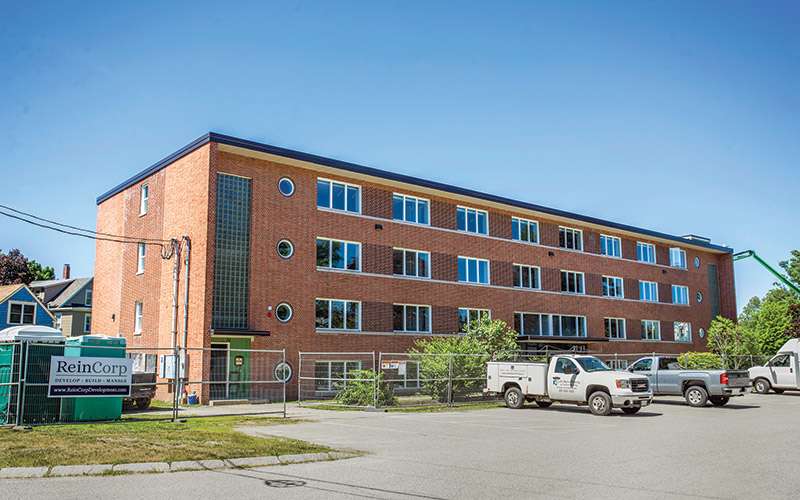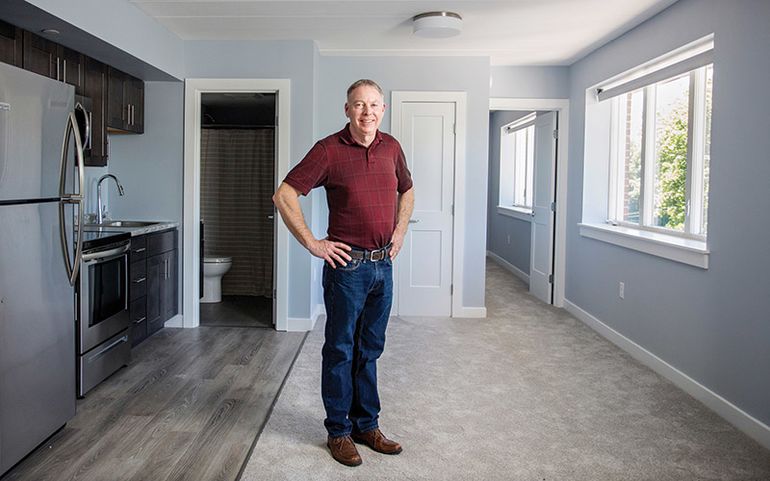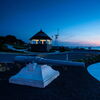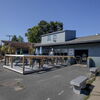
Nasson College's turnaround nearly complete with conversion of Marland Hall into senior housing
 Photo / Tim Greenway
Rob Reinken, president of ReinCorp, in a two-bedroom apartment in Marland Hall on the former campus of Nasson College in Springvale.
Photo / Tim Greenway
Rob Reinken, president of ReinCorp, in a two-bedroom apartment in Marland Hall on the former campus of Nasson College in Springvale.
Rob Reinken was at his latest development project a few weeks ago when he saw a woman out in front taking photos. He asked if he could help her.
“She said, 'This was my dorm!,'” Reinken says. “So I showed her around.”
In a month, the woman could come back to live in Marland Hall on the former Nasson College campus if she wants to — Reinken is renovating the 1956 four-story dorm into 18 units of 55-plus housing.
It's been a long road back since Nasson closed on May 1, 1983. Many of the buildings deteriorated, vacant for decades, as development plans fizzled and died.
ReinCorp's redevelopment of the former dorm is a milestone — it's the last building remaining on the core campus of the former liberal arts college to be redeveloped. Reinken owns six of the remaining buildings on the original campus.
Several buildings, including Allen Hall, a dorm similar to Marland, and the former dining commons, were torn down years ago.
Three “upper campus” buildings not owned by Reinken are vacant and have yet to be developed.
It's not the same campus the Nasson alumna with the camera left behind. Like the village around it, it's grown into something different after years of struggle.
'Nothing but a sandbox'

When Nasson College declared bankruptcy in November 1982 and closed the following spring, it was the second of a brutal economic one-two punch for Springvale, which is part of the city of Sanford.
A 1976 urban renewal project had levelled most of the two and three-story clapboard and brick downtown commercial buildings. When Nasson closed, the downtown around it was still pocked with vacant lots.
The college, which was established in 1912 and at its height in the 1960s had 900 students, “was a wonderful asset to our community,” says Harland Eastman, president of the Sanford/Springvale Historical Society. “It was obviously a large part of Springvale's prosperity.”
When the college closed in 1983, “people were sorry, shocked,” he says. “Most of the people around in 1983 had never lived here at a time when it wasn't part of Springvale.”
The blow was felt deeply because, seven years before, “Springvale suffered a disaster with far greater impact, urban renewal, with the delusion that as vacant land became available in Springvale, developers would rush in,” he says.
“For 20 years, it was nothing but a sandbox,” he says.
Adding to the pain, a series of possible development plans that didn't succeed kept the Nasson campus in limbo. It had a short revival as a quasi-college with a handful of students in one or two buildings, but the promise of more never developed.
That effort and much of what happened for the next 15 years to the property was driven by a Massachusetts businessman, Edward P. Mattar III, who tied much of it up in lawsuits for years as buildings deteriorated.
Marland Hall renovation
As the Mattar era played out, Reinken, who moved to Sanford in 1986, began buying campus buildings as they became available.
In 1988, he bought and renovated Alumni Hall, the campus' first building, into 12 apartments.
He developed adjacent 12,000-square-foot Brown Hall, the college's second building, into professional office space in 1998. The offices of ReinCorp, as well as other tenants, have space there.
In 1997 and 1998, he developed Folsom I and II, two two-story dorm buildings on the corner of Kirk and Grove streets a block northwest of the campus, into one and two-bedroom apartments.
In 2003, he built a one-story building next to Marland Hall, where the dining commons once was, that house York County Career Center.
The 40,000-square-foot science center, which dates to 1968, was redeveloped by Reinken into medical and professional office space in 2010, with tenants Nasson Health Care and NorDx Maine Health.
Marland Hall, which is approximately 22,000 square feet, is being transformed into 10 one-bedroom and eight two-bedroom senior apartments. Reinken began the project about a year ago and hopes to be ready for occupancy Aug. 1.
Reinken was mostly building homes when the opportunity arose to buy Nasson property. He says his philosophy is to buy property to redevelop, so when home-building levels off, “I can keep everybody working.”
Reinken has owned Marland Hall since 2003, but the economy and other projects kept his plans for senior housing there on hold.
“I don't have the capacity to do more than one property at a time,” he says.
He says it also took time to develop community trust after the beating it took in the years after Nasson closed.
Marland Hall, a four-story brick dorm, once housed the college's Lion's Den coffee shop in its basement.
“By the time I got to the buildings, people were using them to pitch rocks at,” Reinken says.
The building had to be gutted, and windows and infrastructure were replaced. He added thick insulation, both for energy efficiency and noise reduction.
Unlike many older college dorms, Marland had one bathroom for every two rooms, which made making the rooms into apartments more feasible.
The biggest change is an elevator at one end.
The one-bedroom units are a sunny, open and functional 620 square feet. The two-bedroom units are 780 square feet.
Reinken restored the glass-block window that lights the main stairwell, added a fitness center and seating areas, and is redeveloping the Lion's Den into a community room. He isn't removing the large brick fireplace in the room, though it won't be used for wood fires as it was when the college was open.
Redevelopment a group effort
Reinken says the city of Sanford has been a great partner for his projects, supporting development, including using tax increment financing.
And though he owns a majority of the former campus buildings, he says it's been a group effort to redevelop not only the campus, but the village.
The college's large Anderson Learning Center was bought by Sanford, and houses Sanford Community Adult Education and the University College at Sanford. In the basement is the Nasson Heritage Center, run by the Nasson College Alumni Association.
The association was instrumental in keeping the memory of the college alive after it closed, and led an effort to redevelop the former gym and Little Theatre, which opened in 2007 as the Nasson Community Center.
Much of the land left vacant in Springvale after the 1976 urban renewal tear-down has been redeveloped.
Eastman, the historical society president, says the redevelopment in Springvale has been “wonderful,” thanks in a large part to developer Lionel Sevigny. “He made a major investment in the village,” he says.
Eastman, 89, a Springvale native, also has played a role in Springvale's resurgence, with a focus on historical renovation. The society and associated historical committee, of which he's the chairman, have restored the 1873 former Sanford town hall into a museum and headquarters for the historical society and the next-door Victorian Goodwin house, among other projects.
Jim Nimon, executive director of the Sanford Regional Economic Growth Council, says the effort on the campus and in the village has paid off.
“It's hard to replace a college campus which had 900 students in its heyday and the multiplier effect on housing, retail and services,” he says. “However, strides have been made and the former buildings now play an important role and have a considerable economic impact, with housing, state government, local education, health services, a community center and the arts. These are elements that provide a nice mix and work well in the village center.”
Nimon says that the village itself, too, is becoming more economically vital.
“There's a good foundation today and more opportunities to come as buildings presently owned by the city and the state open up in the near future for further development,” he says.
Nimon says that the influx of residents in the village will add to it.
“To have a vibrant downtown you need to have people living there,” he says. “The addition of these residences will add foot traffic for existing merchants and make demands for future goods and services.”
Reinken says Springvale has “regained that village appeal.” He says the people who will live in the Marland building want a village they can walk around in, and the feeling of community it brings.
'Great things are happening here'
Reinken is acutely aware of the fits and starts of Sanford's economy. The 18 miles that separate it from the Maine Turnpike makes a big difference.
“We have a unique economy,” he says. “We tend to be a little more careful, we're more challenging to get to.”
He says the effects of the recession that began in 2008 are finally wearing away and the recent development boom is finally arriving.
“We were slower,” he says. “Portland already has come out of it somewhat the last few years, but it's only reaching us now.”
Reinken designs, builds and manages his developments. Other current ones include Cottonwood Meadow, a 15-lot subdivision under construction in South Sanford. He also has a possible downtown Sanford mixed-use project on the drawing board. Past projects include several housing developments in the area.
“I'm very bullish on Sanford, especially the village of Springvale,” he says. “Great things are happening here.”
Both he and Nimon cite the addition of a 48-mile high-speed internet loop to the city and Unitil natural gas as economic boosters that will help invigorate the city's business climate.
Reinken has seen a lot happen since he redeveloped his first Nasson campus building in 1988, only five years after the college closed.
When he first became involved in buying campus properties, “the community was still sad, still hurt in many ways” and reluctant to see the campus redeveloped into something that wasn't a college.
“The biggest change,” he says, “is that Sanford has gone from a community not necessarily pro-development to a place that really wants to grow the community in the right ways.”










Comments